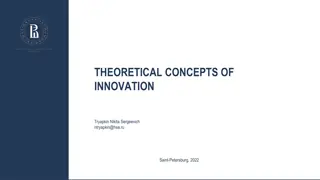
Impact of FDI on Innovation in Developing Countries
Explore the comparison of FDI impact on innovation in India and China, core elements of National Innovation Systems, and the role of FDI in enhancing National Innovation Capability in developing countries. Learn about the different approaches to FDI, its influence on R&D, and the outcomes in academia and research collaborations.
Uploaded on | 4 Views
Download Presentation

Please find below an Image/Link to download the presentation.
The content on the website is provided AS IS for your information and personal use only. It may not be sold, licensed, or shared on other websites without obtaining consent from the author. If you encounter any issues during the download, it is possible that the publisher has removed the file from their server.
You are allowed to download the files provided on this website for personal or commercial use, subject to the condition that they are used lawfully. All files are the property of their respective owners.
The content on the website is provided AS IS for your information and personal use only. It may not be sold, licensed, or shared on other websites without obtaining consent from the author.
E N D
Presentation Transcript
Global Development Conference on STI for Global Development Conference on STI for Development Development 22 22- -23 March 2018 23 March 2018 Impact of FDI on Innovation: A comparison of experiences of India and China Reji K. Joseph Associate Professor, ISID
Innovation: Some stylised facts Innovation: Some stylised facts Uncertainty: technical outcomes of innovation process cannot be known ex ante. Incremental and radical: technical and economic dimensions. Gradual and cumulative process. All most all innovations contain new application of existing knowledge. Innovation involves exploring and searching. Innovation is the process of contributing to the stock of knowledge and adding economic value to the knowledge. Innovation is interactive in nature. Interaction creates multiplier effect at national level. National innovation capability is the ability of a country as a political, cultural and economic entity to contribute to the stock of knowledge and add economic value to the knowledge. It depends on the national innovation system.
Core elements of NIS Core elements of NIS Internal organisation of firms Inter-firm relationship Role of the public sector Institutional set-up of the financial sector R&D intensity and R&D organisation Education and training system
What is FDI? What is FDI? Three approaches to FDI. Having control or significant degree of influence on the management of an enterprise (IMF). Lasting interest (OECD). Voting power in the rage of 10-50% - significant degree of influence; Voting power above 50% - control 10% equity shareholding is the benchmark Includes private equity (PE) investments. PE funds accounted for one-fourth of M&As in 2014 (8% of total FDI flows in 2014). Realistic FDI foreign investors investing in their core business area Exclude private equity investments FDI supplements domestic capital. Relatively stable financing mechanism, better than external commercial borrowing. What should be the approach to identify FDI in R&D? Approaches of control/influence/realistic FDI ignore the aspect of dependent innovation FDI as a source of supplementing domestic capital doesn t contain associated advantages , but it can promote innovation by adding more capital.
Impact of FDI on National Innovation Capability (in a Impact of FDI on National Innovation Capability (in a developing country context) developing country context) Domestic Production and Service *Movement of Personnel *Collaborative Research *Contract Research *Transfer of Technology *Training of Personnel * Financing R&D Academia Academia * Upgradation of Curriculum * Upgradation of Curriculum *Scholarships *Scholarships *Funding of Chair Professors *Funding of Chair Professors *Collaborative Research *Collaborative Research *Contract Research *Contract Research *Joint Research *Joint Research Centres FDI in R&D FDI in R&D Subsidiaries Subsidiaries Centres Joint Joint Ventures Ventures Outcome Outcome Outcome *Patents Granted *Patents Granted *Increase in the Technology *Increase in the Technology Component of Exports Component of Exports *Access to Global Market *Access to Global Market *Spin *Spin- -Off Firms Off Firms *Competitiveness *Competitiveness *Skill Development *Skill Development *Passing Out of Readily Employable Graduates *Exposure to Global Network *Moving Up in Human Resource Capability *Spin-off Firms Recruitment Movement of Personnel Outward FDI
Impact of FDI in R&D on innovation in Two Different Eras Impact of FDI in R&D on innovation in Two Different Eras During classical multilateralism (1955-1975) Multi-domestic industries, MNC affiliates had an independent existence (not much impacted by what happens to affiliates in other countries) Support laboratories, locally integrated laboratories, internationally independent laboratories. In Global Innovation Networks GIN refers to the the establishment within a multinational enterprise of one or more research and development affiliate facilities at different locations around the world, along with the consequent R&D management, specialization decisions, and exchange of information among them and the parent company . Two Principles R&D specialisation and cooperation in R&D Enables MNCs to benefit from international specialisation across borders Those participants in the chain perform certain tasks in the entire innovation process
R&D % of GDP R&D % of GDP 2.5 2 1.5 1 0.5 0 1995-96 1996-97 1997-98 1998-99 1999-00 2000-01 2001-02 2002-03 2003-04 2005-06 2006-07 2007-08 2008-09 2009-10 2010-11 2011-12 2012-13 2013-14 2014-15 2004-05 India China
Any impact of FDI on R&D? Any impact of FDI on R&D? China: R&D % GDP increased from less than 1% to more than 2% in a matter of 12 years, by 2013. This S&T take off is similar to that of most OECD countries. Competing Chinese firms increasing R&D spending - Huawei, Lenovo, ZTE, etc. Larger role of private enterprises in R&D more than 80% JVs account for 55% of R&D expenditure by foreign funded enterprises in 2013 A study shows that: 84% of foreign R&D centres trained personnel in China and 21% trained personnel abroad 90% of those received training left the foreign funded firm to either start a new venture or to join competing Chinese firm 27% firms introduced most advanced technology of their parent firms, 2% introduced technologies which were not previously used in China and 35% introduced technologies which were considered to be most advanced level in China Motorola engaged with about 250 local firms for supplies. In many cases, in such collaborations the foreign partner provides the designs and personnel
Role of Government in China Role of Government in China Government s vision about the role for the indigenous sector and enhanced support for basic research The National Guideline on China's Long-and Medium - Term Plan for Science and technology Development (2006-20) calls for continued openness for foreign technology and at the same time "assimilation of foreign technology inputs as a continuous means of developing indigenous technologies" It calls for reduction of China's dependence on foreign technology to 30% in 15 years Realising increase in the applied R&D, China s 11th Five-Year Plan (2006-10) highlighted the increased funding and attention for basic research Incentives for R&D by foreign funded enterprises Chinese OFDI in R&D Sweden (telecommunications), Italy (automobile design) FDI in R&D in China was in response to government s interventions to shape the NIS. Hence, it has strong linkages with Chinese NIS.
Impact of FDI in R&D on innovation in India Impact of FDI in R&D on innovation in India India has become a favourite destination among developing countries in FDI in R&D. Bulk of FDI in R&D in in IT, followed by pharmaceuticals and laboratory level R&D. Aimed at taking advantage of low salary of skilled personnel in India Minimal linkages with academia and indigenous industry Only 10% of foreign R&D centres in India take patents in India, implying that much of the R&D undertaken by FDI in R&D is not relevant for India.
What explains? Chinese experience is more akin to classical multilateralism Most of FDI in manufacturing. Initially for adapting to Chinese market and later for producing for global market. R&D of majority owned affiliates of US parent firms 84% in manufacturing in 2006. Declined to 49% in 2014. Does the focus of FDI in R&D follow a similar pattern as that of growing share of services in GDP of China? India seems to be specialising in skilled services in the global network of R&D. Nearly half (46%) of R&D of majority owned affiliates of US parent firms is in R&D services in 2014. The remaining half (54%) is in manufacturing and services (except R&D services). One needs to examine whether this R&D is to support participation in GPNs.






















